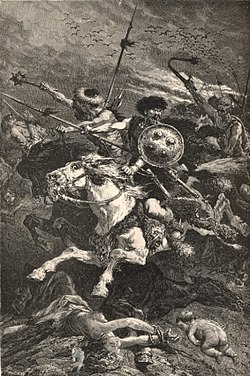Battle of Chalons
| Battle of the Catalaunian Plains | |||||||
|---|---|---|---|---|---|---|---|
| Part of the Hunnic invasion of Gaul | |||||||
 The Huns at the Battle of Chalons by Alphonse de Neuville (1836–85) |
|||||||
|
|||||||
| Belligerents | |||||||
|
Western Roman Empire Visigoths Salian Franks Burgundians Saxons Armoricans Alans |
Hunnic Empire Amali Goths Rugians Scirii Thuringians Franks Gepids Burgundians Heruli |
||||||
| Commanders and leaders | |||||||
|
Flavius Aetius Theodoric † Sangiban Thorismund Theodoric II Merovech Gundioc |
Attila the Hun Valamir Thiudimer Vidimer Ardaric Childeric I Odoacer Andag Laudaricus † |
||||||
| Strength | |||||||
| 50,000-80,000 | 50,000-80,000 | ||||||
| Casualties and losses | |||||||
| Unknown | Unknown | ||||||
The Battle of the Catalaunian Plains (or Fields), also called the Battle of Châlons or the Battle of Maurica, took place on June 20, 451 AD between a coalition led by the Roman general Flavius Aetius and the Visigothic king Theodoric I against the Huns and their vassals commanded by their king Attila. It was one of the last major military operations of the Western Roman Empire, although Germanic foederati composed the majority of the coalition army. Whether the battle was strategically conclusive is disputed: The Romans stopped the Huns' attempt to establish vassals in Roman Gaul, and installed Merovech as king of the Franks. However, the Huns successfully looted and pillaged much of Gaul and crippled the military capacity of the Romans and Visigoths. The Hunnic Empire was later dismantled by a coalition of their Germanic vassals at the Battle of Nedao in 454.
By 450 AD Roman authority over Gaul had been restored in much of the province, although control over all of the provinces beyond Italy was continuing to diminish. Armorica was only nominally part of the empire, and Germanic tribes occupying Roman territory had been forcibly settled and bound by treaty as Foederati under their own leaders. Northern Gaul between the Rhine north of Xanten and the Leie river (Germania Secunda) had unofficially been abandoned to the Salian Franks. The Visigoths on the River Garonne were growing restive, but still holding to their treaty. The Burgundians in Sapaudia were more submissive, but likewise awaiting an opening for revolt. The Alans on the Loire and in Valentinois were more loyal, having served the Romans since the defeat of Jovinus in 411 and the siege of Bazas in 414. The parts of Gaul still securely in Roman control were the Mediterranean coastline; a region including Aurelianum (present-day Orléans) along the Seine and the Loire as far north as Soissons and Arras; the middle and upper Rhine to Cologne; and downstream along the Rhône River.
...
Wikipedia
